As you might imagine, working dog breeds are dogs that were bred to, well, work.
Many of these dogs are still put to work around the world today. It isn’t uncommon to find a husky pulling a sled or a Great Pyrenees guarding a flock of sheep, for example.
However, the vast majority of these dogs are companion animals today. Still, because they were initially bred to work, they are not always as laidback and easy to take care of as other breeds.
Before choosing a working dog, you need to consider very carefully whether or not you can handle their needs. We’ll discuss several popular working breeds below, but first, let’s talk about some of the traits most working dogs exhibit.
Working Dog Breeds: Key Takeaways
- Working dogs comprise a group of broadly similar breeds, who were initially developed to perform a variety of different jobs, ranging from guarding duties to sled-pulling.
- The AKC currently recognizes 31 breeds in the working group, including huskies, mastiffs, Great Danes, and several other familiar breeds.
- Several breeds in the working group can make excellent family pets, but others are quite large and assertive, making them inappropriate for inexperienced owners.

Common Characteristics of Working Dog Breeds
Although dogs in the working group obviously vary from one breed to the next (as well as among individuals), most exhibit a few similar characteristics, aptitudes, and tendencies.
Medium to Giant in Size
Because these dogs were bred to do some sort of work, they often range from medium to giant in size. These dogs are big and bulky; most will weigh at least 40 pounds, and some may be up to 200 pounds in extreme cases.
This is something to keep in mind if you’re considering adding one of these dogs to your family. Working dog breeds are often unsuitable for apartments and small spaces for this reason.
Intelligent
To do their job correctly, many of these breeds had to be intelligent. Today, many of them still retain this intelligence and are therefore easier to train than some other breeds.
Of course, this intelligence is a double-edged sword. These dogs require mental stimulation to stay happy. Many of them want to work.
This can be done through a consistent, energy-draining, and fun training program, which is often the most practical solution. However, interactive food toys and games are also excellent options.
Usually People-Centered
These canines were bred to work with and for their humans, so they’re typically pretty people-centered. Many of them are one-person-dogs, though, which means they’ll bond closely with one person and might not listen to anyone else.
This might not bother all owners, but it can be a point of contention in some families.

Alert
Many working dogs were used as guard dogs – or at least, they could be used as guard dogs. Because of this, many are very alert and will guard instinctually, even if their ancestors haven’t guarded anything for a long time.
Many of these dogs will bark at neighbors as they walk by or be a little edgy around strangers. Of course, because they’re so intelligent and many are eager to please their person, this can be offset by proper training.
Often Protective
Again, these dogs were often used as guard dogs in some capacity, even if that wasn’t their breed’s primary purpose. And this means that many are still protective to some extent today.
For some owners, this may be considered a good thing. Perhaps you’re looking for a dog that is a bit more protective. In this case, many of these breeds are going to be suitable.
However, if you aren’t looking for a protective dog, you’re going to have to be careful about what working breed you adopt.

Early socialization is essential for all of these breeds to ensure that they aren’t too protective, even if you’re looking for a guard dog.
You don’t want your dog automatically assuming that everyone he sees is an enemy, which is where the importance of socialization and training comes in.
List of Working Dog Breeds
The AKC currently recognizes 31 different working breeds. We’ll try to give you a brief overview of each below, to help you whittle down your options.
1. Siberian Husky
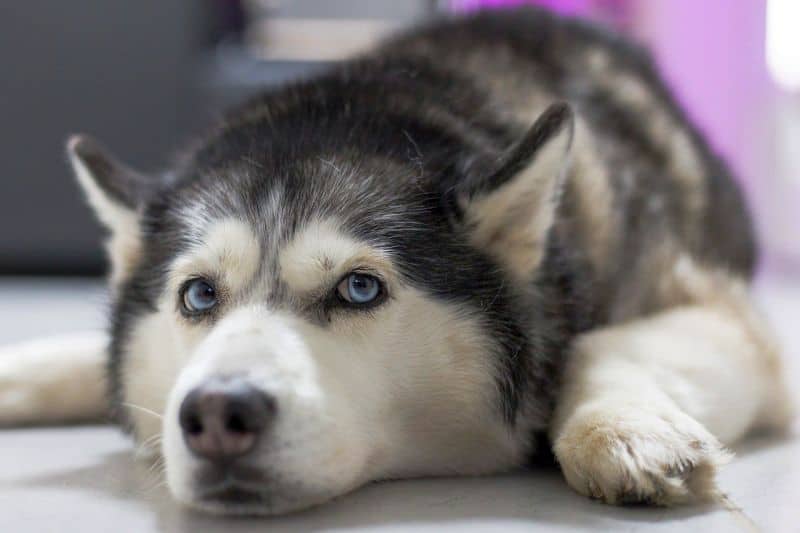
Siberian huskies are great dogs, who can be a decent choice for first-time owners, but they are also a huge handful.
They’re three-year-olds in an athlete’s body. They are trainable but easily distracted and very opinionated – if they don’t want to do something, they’ll let you know with that classic blue-eyed stare and some hollering.
And while that husky coat is certainly beautiful, it will eventually end up covering everything you own, as these dogs are epic shedders. Daily brushing is a must, and you’ll even want to invest in a quality pet vacuum to maintain your home.
Huskies can certainly make excellent family pets, but you need to know what you’re getting into and have a plan for keeping Huskies busy with toys.
2. Alaskan Malamute

In many ways, malamutes are pretty similar to Siberian huskies, except they’re a bit bigger-boned and larger overall.
They’re also pretty similar to huskies personality-wise. As long as they’re socialized when young, they are usually playful and gentle with two-footers.
Just be prepared to dedicate quite a bit of time to exercise and training, however, before adding a malamute to your family. You’ll also need to be willing to perform some grooming, including regular (and thorough) brushing — these floofs shed just as much as huskies.
3. Bernese Mountain Dog

If you’re a new dog owner, a Bernese mountain dog might be the best option for you in this group. These tricolored cuties have great personalities and make loving, friendly companions.
Bernese mountain dogs are large and born to work, but they’re also affectionate and quite gentle. They’re also pretty easy-going doggos, who love just paling around with their people.
These dogs do best in cold weather, as they are built for the farmlands of Switzerland. So, owners living in the sunbelt may want to consider a breed better-suited for their climate.
4. Greater Swiss Mountain Dog
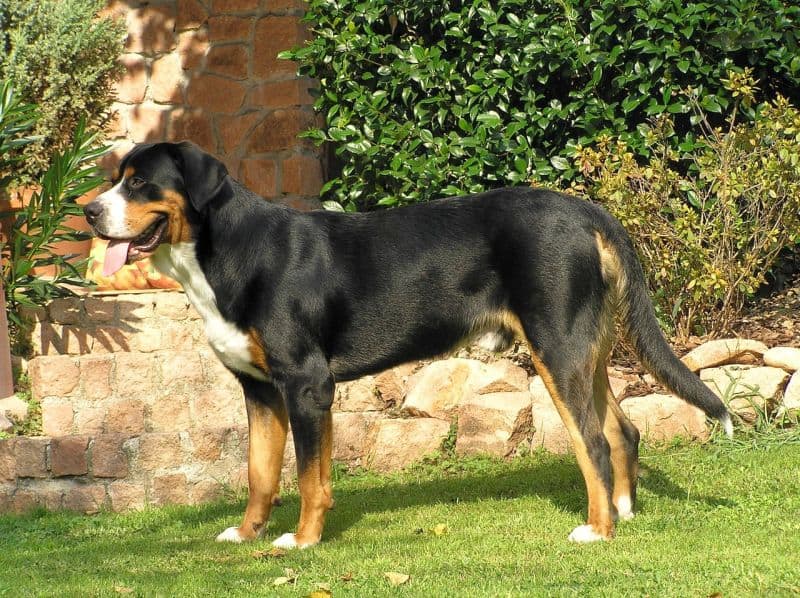
A close relative of the Bernese mountain dog, the greater Swiss mountain dog is known for being a dependable and hard worker.
The breed was originally developed for herding purposes, but they were also used in a variety of other roles. And because their herding instincts are not as strong today as some other dog breeds, they probably won’t try to herd your children.
Greater Swiss mountain dogs do require quite a bit of exercise, but they are usually friendly and easy to train.
5. Akita

These dogs hail from Japan, where they were used as guard dogs for centuries. They have an imposing stance and powerful build, as well as the protective instincts to make would-be trouble-makers think twice.
Although affectionate with their peeps, Akitas are not only strong but also suspicious of strangers, making them a poor choice for beginners. They can also cause problems for families with other dogs, as they don’t always get along particularly well with other canines.
6. Anatolian Shepherd Dog

Anatolian shepherd dogs are descended from some of the oldest domestic-canine bloodlines in the world. They are a timeless breed with no-frills.
Mostly used for guarding purposes, many of these puppers are still very concerned with protecting their friends and family. They do require regular training and socialization, as well as a firm, yet loving owner, as they can be quite demanding.
7. Black Russian Terrier

These dogs are HUGE. Just look at that beautiful giant! In fact, black Russian terriers often tip the scales at 140 pounds, and they can stand as high as 30 inches.
These confident and clever canines are straightforward to train, but they’re also very energetic. So, you’ll need to be prepared to help them burn off excess energy on a daily basis if you adopt one.
Because of their cute-but-coarse coats, black Russian terriers require regular grooming with near-daily brushing.
8. Boxer
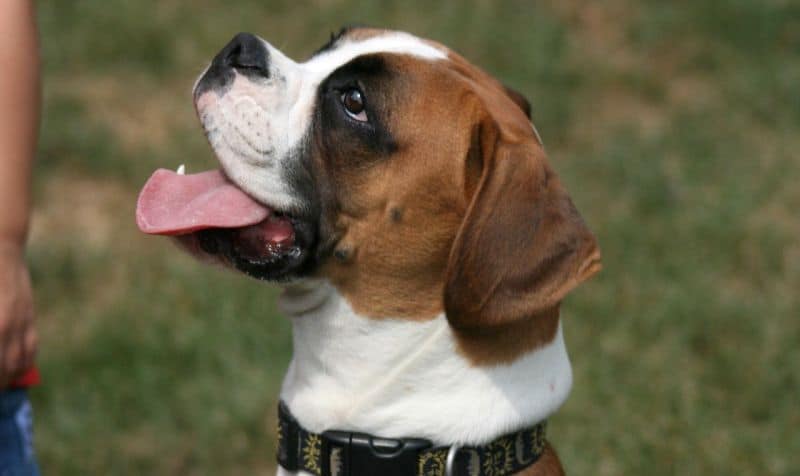
The athletic boxer is not only affectionate and friendly, but unbelievably upbeat and playful, making the breed one of the best options for new dog owners.
They are protective to some extent, but not nearly to the same level as Akitas or some of the other working breeds discussed here.
Boxers are pretty high-energy dogs who need lots of exercise, but they have low-maintenance coats, and they’re famous for being gentle and patient with children.
9. Bullmastiff
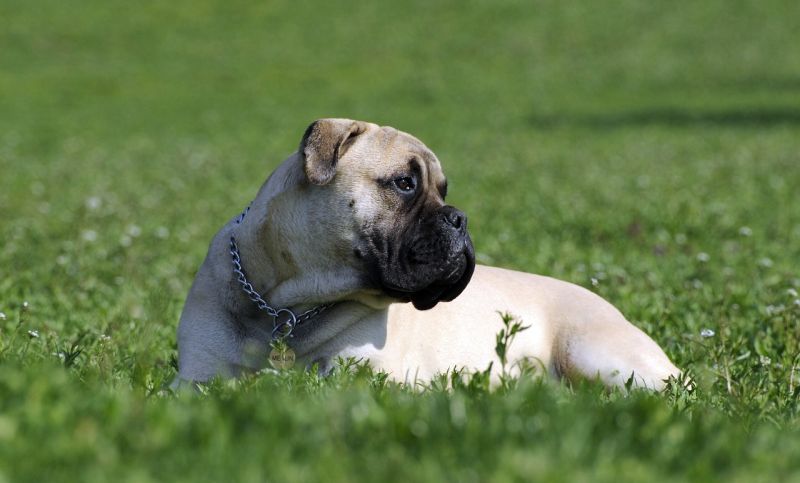
Bullmastiffs were bred to protect English forests from poachers, where they fearlessly pursued trespassers. But despite this history, they are quite docile today, especially while chillin’ at home with their peeps.
Like most other dogs, bullmastiffs require a significant amount of socialization while they’re young. But they are great protectors and family companions if you have some experience with big, assertive breeds, as well as the time to devote to them.
10. Cane Corso
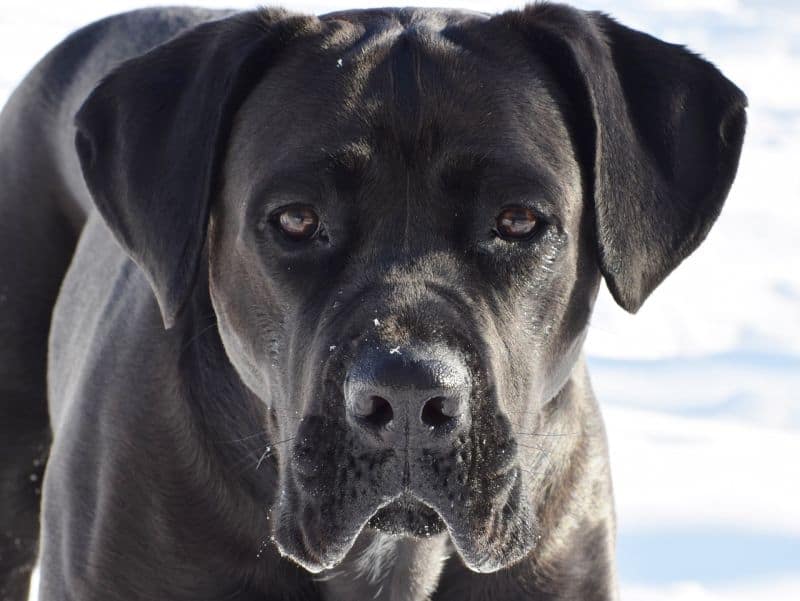
This breed’s name translates roughly to “bodyguard-dog.” As you might imagine, they have strong protective instincts and an opposing appearance, which works as their first line of defense against intruders.
But the cane corso is generally nothing more than a snuggle-bug when hanging out at home with the pack. They are loyal and intelligent, but they are also strong-willed (and just plain strong), so they’re not a good choice for novice owners.
11. Chinook

This dog breed is one of the rarest ones out there — at one point, breed’s population dropped to near single digits. But fortunately, they’ve bounced back a bit in recent years (there are likely more than 800 hundred running around being good boys and girls today).
They were bred as dual-purposed haulers and had significant levels of speed and strength. Today, they are known for being calm, people-oriented dogs, especially around children.
These canines do not have significantly high exercise needs, but you should still expect to take them for regular walks.
12. Doberman Pinscher

These are some of the most popular dogs in this group, ranking as the 17th most popular dog breed in the United States.
Dobermans are fearless and vigilant, making them one of the best guard dogs out there. But they’re very sensitive and gentle with their families, and they are among the most loving dogs in the world.
They do have a few drawbacks though. For example, while they are some of the easiest dogs to train, they also require quite a bit of activity and will get bored (and therefore destructive) quickly.
13. Dogo Argentino

The Dogo Argentino is a short-coated, muscular breed that was initially developed to hunt big game. And we’re not kidding around about “big game.”
These guys and gals hunted wild boar and other formidable foes.
But in the modern world, Dogos perform a variety of duties, ranging from service work to guard-dog duties. They’re usually very sweet and affectionate with family, but they do require early socialization, as they may be too protective around strangers.
14. Dogue de Bordeaux

First of all: Yes. You’ve probably seen this breed on the big screen.
These mastiff-like dogs were bred for guarding – hence their towering, imposing figures. However, with friends and family, they are usually gentle sweethearts.
The dogue de bordeaux is not as easy to train as some other breeds, so you’ll need to have some experience with dogs to succeed with these awesome dogs. Furthermore, finding the right breeder is particularly essential, as some lines are not as friendly as others.
15. Giant Schnauzer
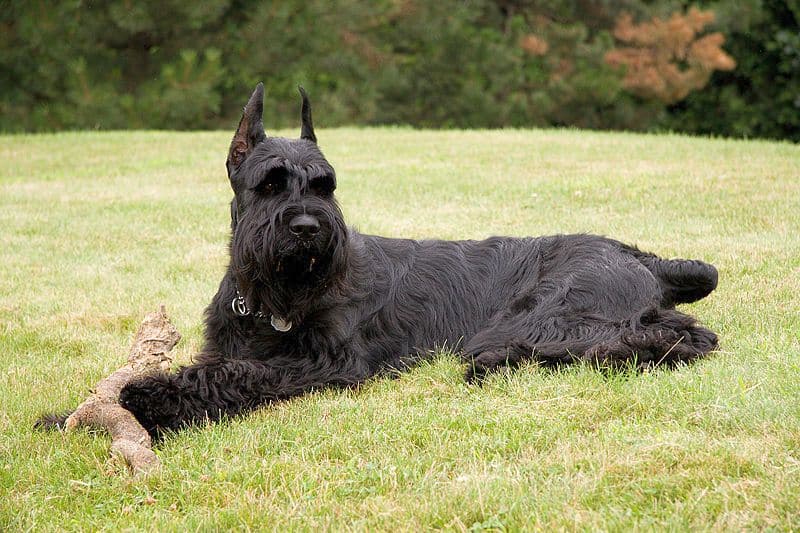
These dogs are simply larger versions of the standard schnauzer, so they share a number of the same traits. And because giant schnauzers are highly intelligent and easy to train, they often make suitable dogs for first-time owners.
They do require a lot of activity and grooming, however, so be sure you’re ready to dedicate that amount of time before adopting one. Giant schnauzers particularly love games that challenge their body and mind.
16. German Pinscher
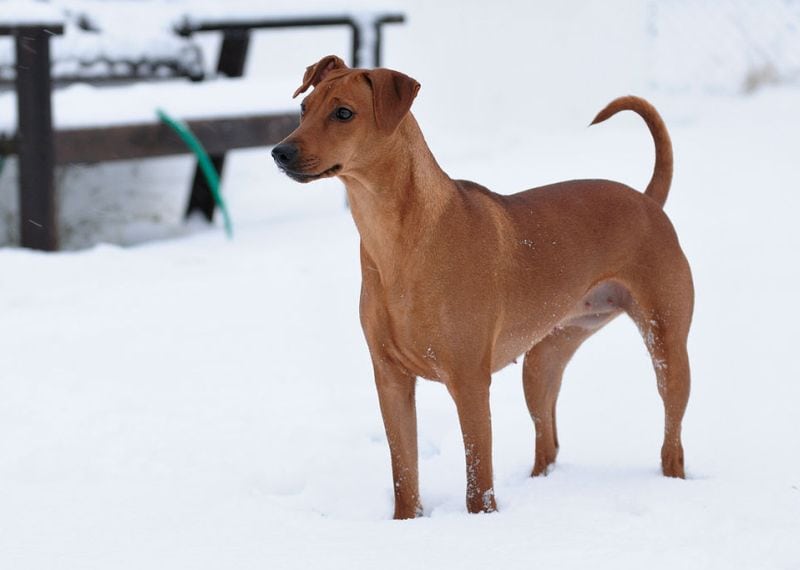
As one of Germany’s oldest breeds, these dogs are known as the prototype of other pinscher breeds.
They are pure, no-nonsense dogs, who were originally developed to catch and kill rats. Perhaps not surprisingly given the rodent-removing role they played, these dogs are smaller than most other working breeds — they rarely exceed 45 pounds or so.
German pinschers do not require much grooming at all but do need quite a bit of exercise. They aren’t the easiest dogs to train, with their high intelligence making them somewhat manipulative.
17. Great Dane

Great Danes are somewhat common and are best known for their gigantic size, as they’re usually considered the largest existing breed. However, these lovable goofballs don’t always seem to understand just how big they are.
Great Danes are quite sweet with their people, but they were bred as protective guardians, and it shows. They are patient with children and overall great family dogs. They even make good service dogs in many cases.
However, these big ‘ol canines do require regular training and socialization to ensure they remain safe.
18. Great Pyrenees

Bred to protect mountain pastures (and to resemble the sheep they were tasked with guarding), Great Pyrenees are immensely powerful. However, like most other huge dogs, they’re usually gentle giants.
They spend most of their time lazing around but can spring into action in a moment’s notice if they need to. They can be a good choice for novices, but they require quite a bit of activity and plenty of room to roam (this is not an apartment-friendly breed).
19. Komondor

We’ll give you a second to enjoy that photo. As you can see, Komondorok (the plural form of Komondor) are unique dogs.
They are large and robust, like most other working breeds, but they have white cords instead of the usual dog hair. As with many other livestock-guarding breeds, this was likely developed to help them resemble the sheep they were guarding, which probably helped keep the sheep at ease.
Komondorok are agile and light-footed despite their large size, and they need plenty of room to run around. They aren’t ideal for beginners and require special grooming, so be sure to do your homework before bringing this breed home.
20. Kuvasz
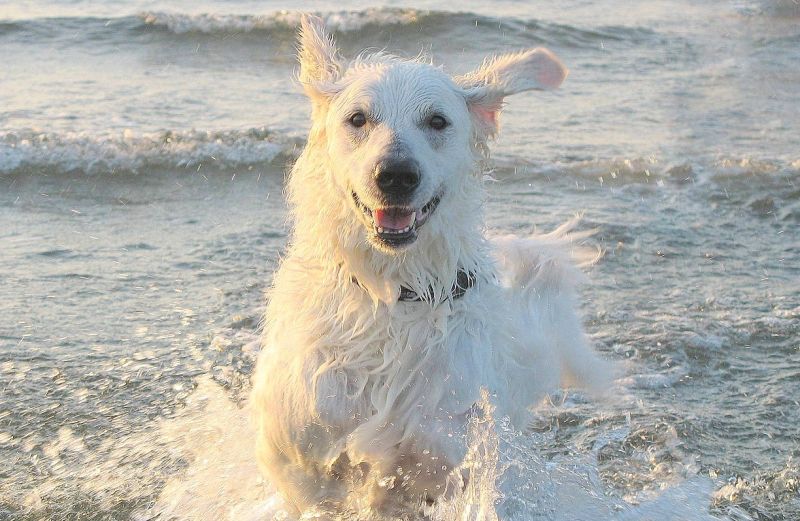
Bred as both hunting dogs and guardians, the kuvasz was originally developed for wealthy nobles. Large dogs, these four footers usually weigh between 70 and 110 pounds or so.
Kuvaszok (another fun plural name) are not as easy to train as other breeds, and they can be very independent. In fact, their overall aloof attitude and willful nature make them only suitable for experienced dog owners.
Nevertheless, these dogs can make excellent companions for the right families — they just need a lot of training and socialization upfront.
21. Leonberger

The Leonberger is a gigantic and powerful dog that is also known for his elegance. Covered in a water-proof, medium-length coat and a black facemask, the breed is pretty easy to identify on sight.
Generally, these dogs are friendly, but they are also excellent watchdogs. They are quite intelligent, but also require plenty of grooming and exercise. They’re not ideal for first-time owners, but they can make good family pets for those with some experience.
22. Mastiff

Formerly called English mastiffs, these giant dogs are relatively popular, especially as far as big breeds are concerned. They’re not ideal for beginners, but many experienced owners fall in love with the breed.
Mastiffs are incredibly loyal and protective while also being friendly to familiar faces. However, they are aloof around strangers, which means that it is vital for them to be socialized early and often. Training is also essential for this breed, if only because of its colossal size.
23. Boerboel

Boerboels are big, broad, and blocky. As you may expect of such gigantic canines, they are considered a mastiff breed (they’re sometimes called South African mastiffs) and likely share a common ancestor with other mastiffs.
Boerboels were bred for guarding purposes, so they don’t make quick friends with strangers. They aren’t a particularly great choice for beginners, and they require regular training and socialization to ensure they remain friendly and agreeable.
24. Neapolitan Mastiff

An instantly recognizable breed, the Neapolitan mastiff is astonishingly huge and covered in profuse wrinkles and folds. But despite their imposing appearance (some weigh more than 150 pounds), these dogs are all love-and-slobber with their packs.
We’re not kidding about the slobber — these dogs drool in bucket-like quantities. They’re not a great selection for those who want a tidy breed.
Neapolitan mastiffs do require a bit of exercise, though not nearly as much as some other breeds. Furthermore, they are challenging to train and often described as stubborn. Because of this, they are not the best option for new owners.
25. Tibetan Mastiff

These ancient canines are supreme guard dogs. They are huge and imposing, generally scaring intruders off before things get serious.
Tibetan mastiffs have the brains to go along with their brawn, but while they are quite intelligent and learn quickly, they do not take to traditional obedience training in most cases. They are very independent dogs and were bred to work by themselves, so they usually rely on their judgment rather than look to their owner for guidance.
Tibetan mastiffs aren’t terribly common, so they often fetch very high prices.
26. Newfoundland

Once again, we have another strikingly colossal dog. It’s almost like there’s a pattern here..
The Newfoundland has a lovely personality and is best known for its affinity for kids. Newfies are quite trainable and respond well to traditional obedience training. Because of these factors, and unlike so many others in the working group, these dogs may make great pets for first-time owners.
At least, that is, first-time owners with enough room for a 150-pound, fun-loving ball of fur.
27. Portuguese Water Dogs

Like Newfies, Portuguese water dogs are another breed that is usually suitable for beginners. They are typically loving, friendly, easy to train, and very eager to please their people. They will pal around with the kids all day, and they’re especially awesome beach companions.
Portuguese water dogs do require professional grooming, but you’ll have your choice of many different cuts, which is kind of cool. These canines do require a fair amount of exercise, so daily walks and plenty of fetch-playing time or swimming are necessary.
28. Rottweiler

These dogs are pretty popular, but they are definitely not a great option for new dog owners. Simply put, these assertive and self-assured four-footers are a whole lot more dog than most novices will be able to handle.
Nevertheless, well-adjusted Rottweilers are calm and confident without being needlessly aggressive, and they’re some of the most loving and affectionate dogs available.
Rotties are obviously awesome at guarding stuff, but — with proper training and an experienced owner — they can also excel in service, support, or therapy contexts too.
29. Samoyed

As you may suspect given their thick, white coats, Samoyeds were bred to work in some of the world’s coldest climates. In fact, the breed’s founders even used them as living lap-warmers!
They are pack animals through and through, so they crave attention and love their people. In fact, they will not like being left alone for extended periods, so these are best-suited for people who spend a lot of time at home.
Samoyeds are smart dogs, but they can also be mischievous if they don’t get the love and attention they need.
30. Standard Schnauzer

The standard schnauzer is really just a smaller version of the giant schnauzer.
These are friendly floofs with fancy facial fur, but don’t let their apperance fool you: They can also be alert and capable watchdogs. They are known for being easy to get along with and gentle with children, so they aren’t a bad choice for novice owners.
Just know that they do require a fair amount of training and socialization to prevent behavioral problems from developing. They also have pretty specific grooming needs, you’ll have to budget for.
31. Saint Bernard

We didn’t intend to leave these wonderful dogs for last — that’s just how the alphabet works out. It certainly shouldn’t be considered a slight against the breed, as we’re big fans of these doggos.
Saint Bernards are one of the most famous working breeds in the world, and you’ve certainly seen them rescuing stranded explorers in movies and cartoons (unfortunately, the whole barrel-of-brandy thing appears to be a myth).
They are watchful and patient, especially with children. They may make excellent family dogs as long they are socialized and trained appropriately. And despite being large, they only require a moderate amount of exercise.
Common Jobs for Working Dog Breeds
Many of these dog breeds still perform jobs today. If someone needs a dog to get something done, they are almost always going to choose a working breed. These canines have work in their blood, and it often shows.
Rottweilers and doberman pinschers, for example, have historically worked in police and military contexts (although they’ve largely been replaced by other breeds in the modern world). That’s because these breeds still hold their natural protective instincts, while still being easy to train.
Other breeds, like the greater Swiss mountain dog are still used for herding. Of course, most dogs who excel at herding are in the — wait for it — herding group, but they don’t have a monopoly on the job.

Herding tendencies can be a hiccup for some families, however. Many of these dog breeds will herd whether you train them to or not. This leads them to try to herd things like children, which can create a serious problem. You also may have trouble training away this behavior.
Many working breeds are also used as service, ESA, and therapy dogs today. They’re highly trainable, which makes them perfect for this job. There are also other breeds used as service dogs, of course, depending on what job needs to be performed.
Other working dogs are used in search and rescue. This job requires not only a high level of intelligence but also great physical stamina – two qualities many working breeds have.
Sled pulling is a task mostly left to the Siberian husky and Alaskan malamute. This was the job they were bred for. With that said, though, some other dog breeds make be involved in sled pulling occasionally as well.
And finally, many of these dog breeds are also used for protection purposes. Many of these canines have natural protective instincts, which makes them perfect guard dogs after a little bit of training.

Be Sure to Choose the Best Working Dog for Your Family
It’s always important to select a breed and individual dog that’ll fit in well with your family. But given their large size, strength, and assertive natures, working breeds demand even more careful consideration.
Most working dogs are not suitable for beginners. However, there are a few that may be okay if you’re ready to devote the necessary amount of time to their care.
All of these dogs require quite a bit of exercise and mental stimulation. They are not dogs that will enjoy being left alone without much to do all day.
So, just be sure that you carefully review the traits of the breed you wish to add to your family and try to meet several in person before bringing home your new dog.
After all, you’ll avoid a lot of headaches if you discover that a given breed is not well suited for you before you bring one home.
You don’t want to add Fido to your family only to discover that your lifestyles are simply incompatible.
Good Working Breeds for Beginners: A Quick Roundup
As we’ve mentioned, some working breeds make good choices for dog-owning novices, but others, well, not so much.
Just to make things easier, we’ve listed the breeds beginners should focus on below (in no particular order):
- Bernese mountain dog
- Standard schnauzer
- Samoyed
- Saint Bernard
- Great Pyrenees
- Portuguese water dog
- Boxer
- Newfoundland
***
Do you have one of these powerful breeds? Thinking about adopting one? Let us know in the comment section below.
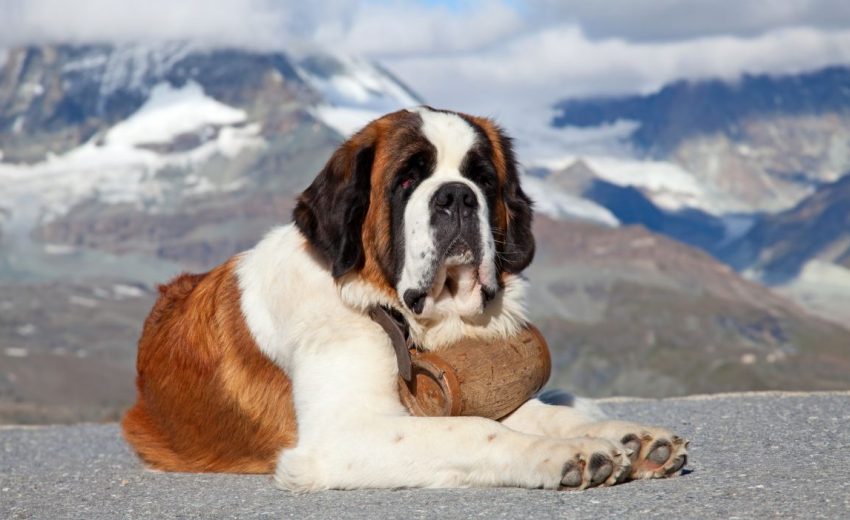






6 Comments
October 7, 2021
I have 6 dogs here in Ecuador.
1. Bernese Mountain Dog
2. Some kind of 25 pound fluff ball that doesn’t shed
3. A German Shepherd x with Lab?
4 Cocker Spaniel
5. Golden Retriever? X with short legged something.
6. Miniature white fluff ball
October 7, 2021
That’s quite the pack, Diane! Thanks for sharing.
🙂
June 20, 2021
I’m the owner of two English Mastiffs, (females) one who weighed 225 pounds, before she passed away with cancer and my current EM puppy who’s two years old and over a hundred pounds. Both dogs became members of our family when they were babies. 6-8 wks and have been the best family dogs in the world! Both bonded with my grandchildren, and remain very protective of their family. They don’t bark unless telling you that someone else is at your house. Very intelligent dogs and easy trained, if you remain consistent. They require room to run off energy, then tend to relax mostly. Lol. Excellent with other animals. Very playful.
June 21, 2021
They sound great, Brenda.
And 225 pounds is quite a big pooch! Couch-cuddling time must something else!
🙂
April 10, 2021
How you have any list of working dogs and you don’t have the German Shepard on it is simply amazing. Makes me wonder what the hell you are smoking!
April 12, 2021
Hey, Mark.
German shepherds are in the herding group.